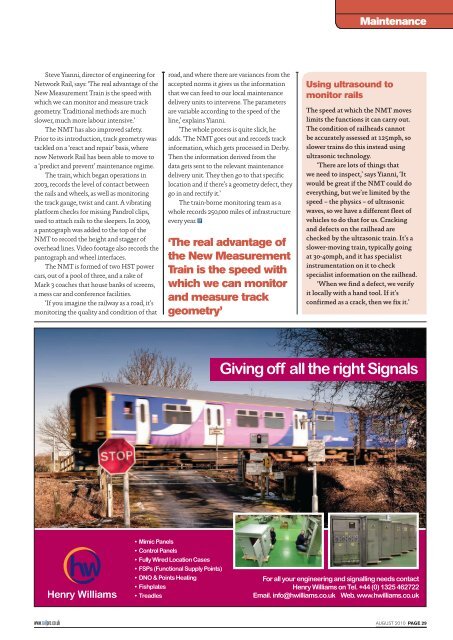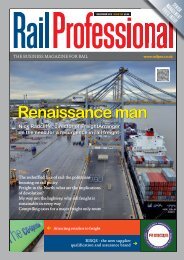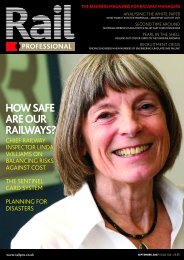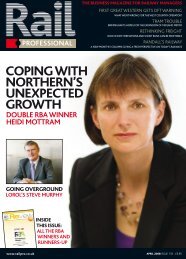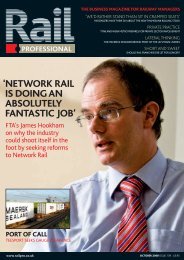View as PDF - Rail Professional
View as PDF - Rail Professional
View as PDF - Rail Professional
Create successful ePaper yourself
Turn your PDF publications into a flip-book with our unique Google optimized e-Paper software.
Maintenance Comment<br />
Steve Yianni, director of engineering for<br />
Network <strong>Rail</strong>, says: ‘The real advantage of the<br />
New Me<strong>as</strong>urement Train is the speed with<br />
which we can monitor and me<strong>as</strong>ure track<br />
geometry. Traditional methods are much<br />
slower, much more labour intensive.’<br />
The NMT h<strong>as</strong> also improved safety.<br />
Prior to its introduction, track geometry w<strong>as</strong><br />
tackled on a ‘react and repair’ b<strong>as</strong>is, where<br />
now Network <strong>Rail</strong> h<strong>as</strong> been able to move to<br />
a ‘predict and prevent’ maintenance regime.<br />
The train, which began operations in<br />
2003, records the level of contact between<br />
the rails and wheels, <strong>as</strong> well <strong>as</strong> monitoring<br />
the track gauge, twist and cant. A vibrating<br />
platform checks for missing Pandrol clips,<br />
used to attach rails to the sleepers. In 2009,<br />
a pantograph w<strong>as</strong> added to the top of the<br />
NMT to record the height and stagger of<br />
overhead lines. Video footage also records the<br />
pantograph and wheel interfaces.<br />
The NMT is formed of two HST power<br />
cars, out of a pool of three, and a rake of<br />
Mark 3 coaches that house banks of screens,<br />
a mess car and conference facilities.<br />
‘If you imagine the railway <strong>as</strong> a road, it’s<br />
monitoring the quality and condition of that<br />
road, and where there are variances from the<br />
accepted norms it gives us the information<br />
that we can feed to our local maintenance<br />
delivery units to intervene. The parameters<br />
are variable according to the speed of the<br />
line,’ explains Yianni.<br />
‘The whole process is quite slick, he<br />
adds. ‘The NMT goes out and records track<br />
information, which gets processed in Derby.<br />
Then the information derived from the<br />
data gets sent to the relevant maintenance<br />
delivery unit. They then go to that specific<br />
location and if there’s a geometry defect, they<br />
go in and rectify it.’<br />
The train-borne monitoring team <strong>as</strong> a<br />
whole records 250,000 miles of infr<strong>as</strong>tructure<br />
every year.<br />
‘The real advantage of<br />
the New Me<strong>as</strong>urement<br />
Train is the speed with<br />
which we can monitor<br />
and me<strong>as</strong>ure track<br />
geometry’<br />
Using ultr<strong>as</strong>ound to<br />
monitor rails<br />
The speed at which the NMT moves<br />
limits the functions it can carry out.<br />
The condition of railheads cannot<br />
be accurately <strong>as</strong>sessed at 125mph, so<br />
slower trains do this instead using<br />
ultr<strong>as</strong>onic technology.<br />
‘There are lots of things that<br />
we need to inspect,’ says Yianni, ‘It<br />
would be great if the NMT could do<br />
everything, but we’re limited by the<br />
speed – the physics – of ultr<strong>as</strong>onic<br />
waves, so we have a different fleet of<br />
vehicles to do that for us. Cracking<br />
and defects on the railhead are<br />
checked by the ultr<strong>as</strong>onic train. It’s a<br />
slower-moving train, typically going<br />
at 30-40mph, and it h<strong>as</strong> specialist<br />
instrumentation on it to check<br />
specialist information on the railhead.<br />
‘When we find a defect, we verify<br />
it locally with a hand tool. If it’s<br />
confirmed <strong>as</strong> a crack, then we fix it.’<br />
Giving off all the right Signals<br />
• Mimic Panels<br />
• Control Panels<br />
• Fully Wired Location C<strong>as</strong>es<br />
• FSPs (Functional Supply Points)<br />
• DNO & Points Heating<br />
• Fishplates<br />
• Treadles<br />
For all your engineering and signalling needs contact<br />
Henry Williams on Tel. +44 (0) 1325 462722<br />
Email. info@hwilliams.co.uk Web. www.hwilliams.co.uk<br />
AUGUST 2010 PAGE 29


